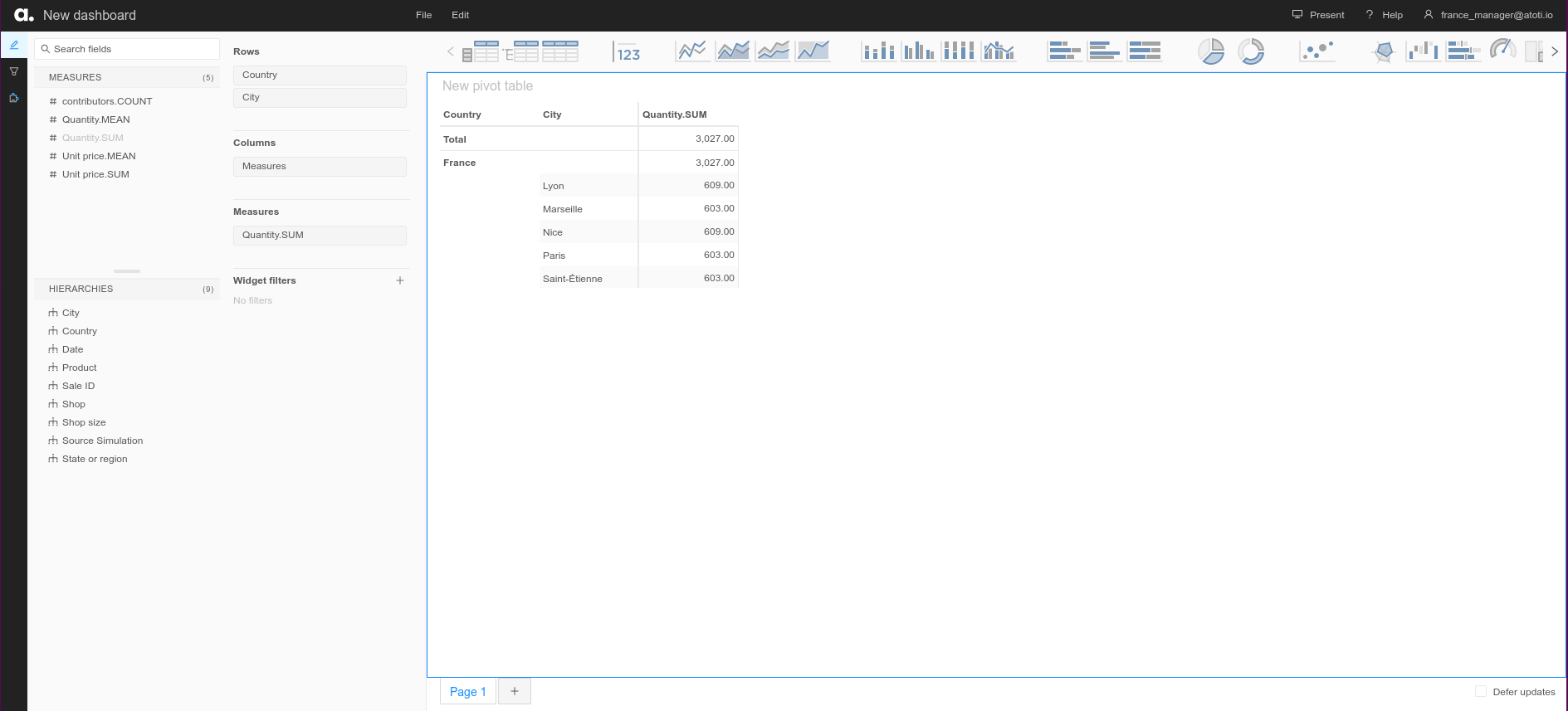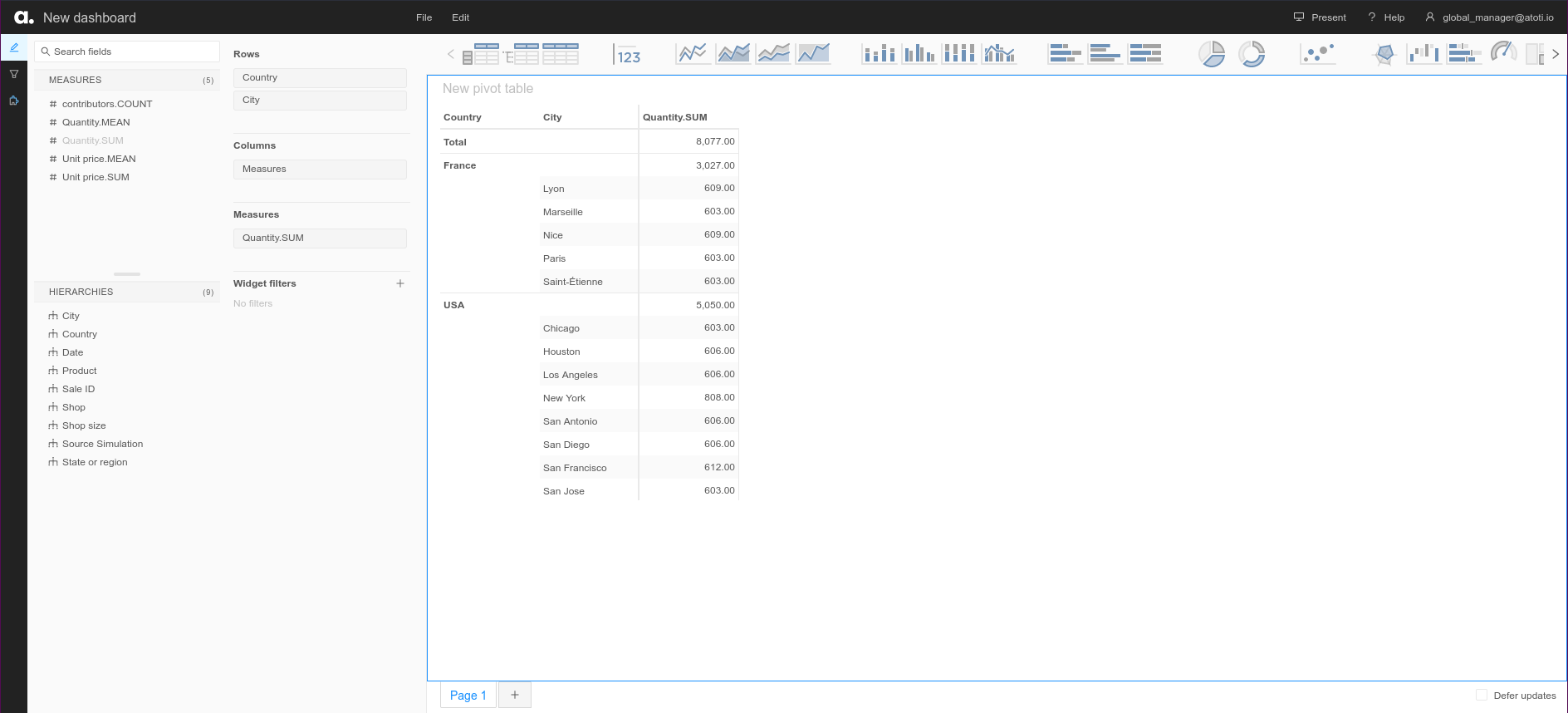Secure a session¶
The atoti-plus plugin is required to follow this how to.
By default, no authentication is required to query an atoti session and the users have access to all the data in the session.
This shows how to configure:
An authentication mechanism to restrict access to the session.
Restrictions to control the data each user is allowed to see.
Configuring the authentication mechanism¶
atoti supports multiple authentication mechanisms. Here we will use the session config to setup OpenID Connect through Auth0:
[1]:
import os
import atoti as tt
session = tt.create_session(
config={
"port": 1234,
"authentication": {
"oidc": {
"provider_id": "auth0",
# The connection details are read from environment variables for improved security.
# See https://12factor.net/config.
"issuer_url": os.environ["AUTH0_ISSUER"],
"client_id": os.environ["AUTH0_CLIENT_ID"],
"client_secret": os.environ["AUTH0_CLIENT_SECRET"],
"scopes": ["email"],
"name_claim": "email",
"roles_claims": ["https://activeviam:eu:auth0:com/roles"],
}
},
}
)
sales_table = session.read_csv("../../tutorial/data/sales.csv", keys=["Sale ID"])
shops_table = session.read_csv("../../tutorial/data/shops.csv", keys=["Shop ID"])
sales_table.join(shops_table, mapping={"Shop": "Shop ID"})
cube = session.create_cube(sales_table)
cube.schema
[1]:
The users configured in Auth0 are:
paris_manager@atoti.io with the roles Paris and atoti user.
france_manager@atoti.io with the roles France and atoti user.
global_manager@atoti.io with only the role atoti user.
Here we are using an Open ID Connect authentication provider, however the configuration of the rest of the session is similar if you are using ldap or kerberos authentication.
Roles and Restrictions¶
Let’s create the roles required so that:
paris_manager@atoti.io only has access to Paris data.
france_manager@atoti.io only has access to France data.
global_manager@atoti.io has access to everything.
Since by default users have access to all the data we only need to create roles and restrictions for the regional managers:
[2]:
role_paris = session.security.create_role(
"ROLE_PARIS", restrictions={"City": ["Paris"]}
)
role_france = session.security.create_role(
"ROLE_FRANCE", restrictions={"Country": ["France"]}
)
We will update the role mapping to create a mapping between the roles our users have in Auth0, and the roles we want them to have in the application.
[3]:
session.security.oidc.role_mapping["Paris"] = [role_paris.name]
session.security.oidc.role_mapping["France"] = [role_france.name]
session.security.oidc.role_mapping["atoti user"] = ["ROLE_USER"]
Connecting to the session¶
As we wanted, paris_manager@atoti.io can only see data for shops in Paris:

When we connect to the application as france_manager@atoti.io, we can only see data for shops in France:

And finally, when we connect as global_manager@atoti.io, we can see data for shops everywhere:

Technical users and service accounts¶
Technical users (also called service accounts) are often required for plugging external services to the application (e.g. to collect metrics with Prometheus). In order to ease the connection of these tools, atoti automatically enables Basic Authentication on the session when another authentication mechanism is configured. Let’s create a technical user and query our application using the session’s REST API.
[4]:
technical_user_name = "Technical user"
technical_user_password = "change me"
technical_user = session.security.basic.create_user(
technical_user_name, password=technical_user_password
)
Let’s create a simple endpoint to test the technical user’s credentials with:
[5]:
from dataclasses import asdict
@session.endpoint("whoami", method="GET")
def whoami(request, user, session):
return asdict(user)
Now let’s query the endpoint we just created by authenticating as the technical user:
[6]:
import requests
response = requests.get(
f"http://localhost:{session.port}/atoti/pyapi/whoami",
auth=(technical_user_name, technical_user_password),
)
response.json()
[6]:
{'name': 'Technical user', 'roles': ['ROLE_USER']}
To finish up, let’s make sure our endpoint is secure if no authentication is provided:
[7]:
response = requests.get(f"http://localhost:{session.port}/atoti/pyapi/whoami")
response.status_code
[7]:
401
We are redirected to the authentication page, our endpoint is inaccessible whithout providing proper authentication.